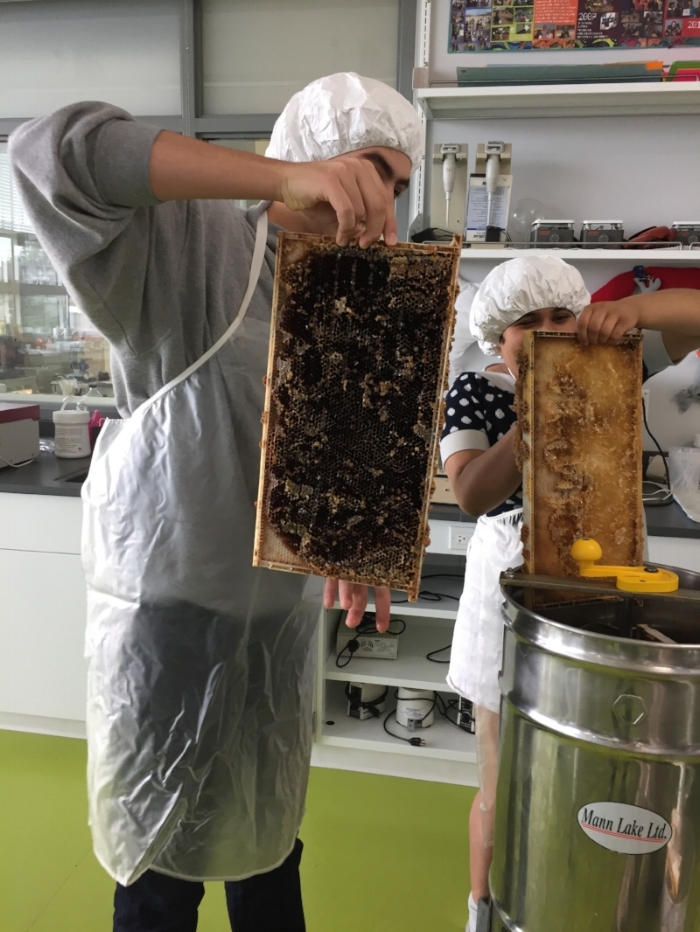There’s no doubt about it: we all love honey. Since the Stone Age, people have been harvesting distilled flower nectar from the hives of honeybees, and generously sweetening our diets and our lives with honey. However, few of us consider how the honey gets from our apian allies into greedy human hands. The process is an involved one, taking a hard working team of individuals and making use of every scrap we get out of it. Last week Seattle Academy’s Bee Club dove into the honey harvest, and all members got to take part in this fun tradition.
The harvest was delayed for almost a month because of the rains in October. Bees can’t fly in the rain, and hive-bound honeybees tend to get cantankerous. This would make retrieving the frames, shelf-like scaffolds that the bees build their honeycomb on very difficult. But according to Dexter Chapin, co-leader of the club with Melinda Mueller, “If it’s a sunny day, you don’t get stung.” Last Thursday and Friday, the sun finally came out, and Dexter was able to open the hives on the roof of the Arts Center and bring back 9 honey-filled frames.
On Monday, in Stream 401, under the leadership of Dexter and Melinda, the “Hive Members” began the harvest. The delicious honey was locked away under wax caps in the comb, so the first step was to cut these off. I found it trickier than expected, because the sticky honey made it hard to control the knife, and we had to be careful to not cut off too much comb and waste honey. After the caps were removed, everyone got to taste the first of the fruits of our labors.
Wild honey has a rich, flowery taste, and a great variety of flavors. Some of the frames held dark honey and some had a lighter color, amber to golden, and a sweeter taste, because of the different flowers that the bees gathered nectar from. The bulk of these flowers grow next door, in the campus of Seattle University, which is the first link in a chain of gardens and parks known as Seattle’s pollinator pathway.
After cutting the caps off, it was time to extract the honey from the comb by spinning the frames in a barrel-like centrifuge powered by a hand crank. In my opinion, nothing compares to the fun and unusual atmosphere of frame-spinning. The smell of honey and beeswax filled the air as teams of three took turns manning the crank and holding the centrifuge to keep it from wobbling too much. It was hard work!
Soon, the frames would start dragging in the honey at the bottom of the barrel, and we would open its spigot and decanted the honey into a bucket with a sieve. Later, the bits of wax that collected there, as well as the wax leftover from cutting the caps, were melted with a teakettle. We’ll use it to make Bee Club’s signature lip balm. Last year, the Hive Members capped their honey jars with the beeswax, too.
The last step in the harvest process is jarring the honey and distributing it. Honey is powerfully antibacterial and will never spoil, so the jars don’t need to be boiled and sealed air-tightly. We formed an assembly line, first filling the jars with honey, then cleaning, capping and labelling them. The frames were returned to the hive, where the busy worker bees would immediately begin rebuilding and restocking the comb, and sugar water would make up for the part of the winter food supply we took.
At last, 37 jars of “Nectar from the Tree of Knowledge” were ready to be doled out amongst Bee Club members. It was the product of the work of millions of flowers, tens of thousands of honeybees, and a tradition as old as civilization. Now, to enjoy the taste of our sweet, sweet honey!



